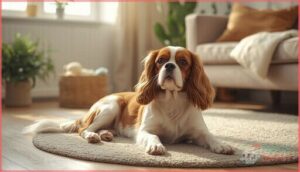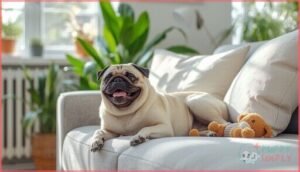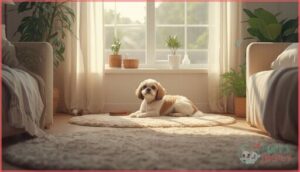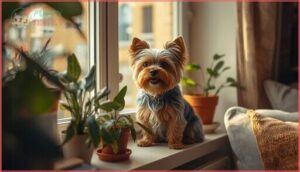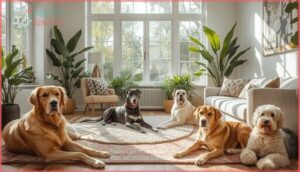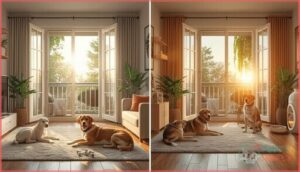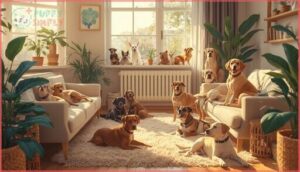This site is supported by our readers. We may earn a commission, at no cost to you, if you purchase through links.

City life doesn’t have to mean giving up the dream of a loyal, tail-wagging companion. The right dog will slide into apartment living as smoothly as a favorite book fits a shelf, making quiet mornings and cozy evenings feel even more inviting.
It’s about finding that perfect balance—affable dog breeds for apartments blend gentle natures with easygoing habits, thriving even when space is a premium. Choose a breed with the right mix of temperament and adaptability, and your apartment transforms from mere square footage to a sanctuary full of belonging and warmth.
Table Of Contents
- Key Takeaways
- Key Traits of Apartment-Friendly Dogs
- Best Small Breeds for Apartment Living
- Larger and Medium Breeds Suited for Apartments
- Essential Care for Apartment Dogs
- Tips for Choosing The Right Apartment Dog
- Frequently Asked Questions (FAQs)
- Are there dog breeds for apartments?
- Which dogs make the best apartment or condo dwellers?
- Are affable Affies good apartment dogs?
- Are apartment-friendly dogs a good choice?
- What are the pros and cons of getting a dog for my apartment?
- What are the best dog breeds for first-time owners?
- How do I know if my apartment is big enough for a dog?
- What are the quietest dog breeds for apartments?
- How much exercise does my apartment dog need?
- How do apartment dogs handle being left alone?
- Conclusion
Key Takeaways
- The best apartment dogs have quiet temperaments, low to moderate energy, and adapt easily to small spaces.
- Small breeds like French Bulldogs, Cavaliers, Pugs, and Chihuahuas thrive in apartments, but some medium and large breeds such as Greyhounds and Bulldogs also fit well.
- Daily exercise, mental stimulation, and consistent training are essential for apartment dogs to stay healthy and well-behaved.
- Grooming needs, shedding, and managing noise are key factors to consider when choosing a dog for apartment living.
Key Traits of Apartment-Friendly Dogs
Not every dog fits the apartment lifestyle, but the right breed can thrive in smaller spaces. You’ll want to look for specific traits that make daily life easier for both you and your neighbors.
Let’s break down the key characteristics that help dogs adapt comfortably to apartment living.
Quiet Temperament and Low Barking
Finding peace in apartment living starts with a quiet demeanor. The quietest dog breeds for apartments—like Basenjis, Greyhounds, and Cavalier King Charles Spaniels—rarely trigger noise complaints. These quiet dogs bark less than once daily, unlike vocal breeds.
Understanding barking triggers and apartment acoustics helps you avoid tension with neighbors. Many quiet breeds, like the French bulldog, are adaptable. Training methods can further minimize nuisance barking, creating harmony in shared spaces.
Adaptability to Small Spaces
Beyond barking, your dog’s ability to thrive in tight quarters matters most. Over 70% of apartment-friendly breeds—like Cavaliers and Pugs—adapt quickly to new surroundings. Consider these traits:
- Space Optimization: Small breeds under 20 pounds use 100-150 square feet efficiently
- Routine Consistency: Adaptable dogs adjust to elevators and hallway encounters calmly
- Indoor Exercise: Most apartment dogs meet activity needs in 50-80 square feet
These breeds make confinement comfortable, not stressful. For apartment success, remember that moderate to low energy is a key characteristic.
Low to Moderate Energy Levels
Energy level directly shapes apartment suitability. Low-energy dog breeds need just 30 to 60 minutes of daily exercise—about 33% less than high-energy breeds. Pugs and Bulldogs thrive with two 10-to-15-minute sessions, while Chihuahuas and Cavaliers do well with 30 to 80 minutes total.
Greyhounds, despite their athletic build, need only 30 minutes of walking before settling in for hours of rest.
Ease of Training and Socialization
You want a dog that listens without a fuss. Cavalier King Charles Spaniels learn commands in under five repetitions with 95% success—that’s breed intelligence working in your favor.
Socialization benefits come naturally in apartments where your dog meets neighbors and hears everyday sounds. This behavioral adaptation lowers anxiety and builds confidence.
Mental stimulation through training makes apartment life smoother for both of you.
Best Small Breeds for Apartment Living
Small dog breeds often make the best apartment companions because they’re naturally suited to limited space. They don’t need a backyard to feel at home, and many have calm temperaments that fit well with close-quarters living.
Here are eight small breeds that thrive in apartments and bring plenty of personality without taking up much room.
French Bulldog
French Bulldogs are perfect apartment dogs because they rarely bark and don’t need much space to feel at home. Their calm, playful nature makes them ideal for smaller living spaces. Consider these apartment-friendly traits:
- They weigh under 28 pounds and stand just 11–13 inches tall
- Their minimal exercise needs suit busy urban lifestyles
- Heat sensitivity requires air conditioning in warmer climates
- Low grooming demands simplify daily care routines
Cavalier King Charles Spaniel
A Cavalier King Charles Spaniel fits apartment living like a glove. Their gentle Spaniel Temperament means calm days and easy socialization with neighbors.
With moderate Exercise Needs—think two short walks—you won’t feel overwhelmed.
Grooming Tips include regular brushing for their silky coat. Health Concerns are manageable with vet checkups.
Use Apartment Enrichment toys to keep this affectionate dog happy indoors.
Pug
A Pug brings comfort into apartment living with its laid-back temperament and charming presence. Small dog breeds like the Pug excel in apartments, with minimal exercise needs and easy-going grooming tips. When you consider their quiet ways and resilience to busy settings, remember these:
- Playful, social companion
- Low exercise
- Simple grooming
- Mild health issues
Chihuahua
When every square foot counts, a Chihuahua fits right in. This tiny breed masters apartment living thanks to its considerable Size Adaptability and sharp dog temperament.
Bursts of play meet modest exercise needs, while their keen mind aids quick training.
If you value small dog breeds, a Chihuahua’s adaptable breed temperament brings years of lively companionship to compact homes.
Shih Tzu
Looking for a quiet companion who thrives on Indoor Play? A Shih Tzu makes a gentle addition to apartment living. These small dogs need light Coat Maintenance and bring peace with low barking.
Breed Health remains steady with regular grooming. If you’re worried about Separation Anxiety, Shih Tzus often settle in nicely—just add patience and a few basic Training Tips.
Dachshund
Ever met a small dog with the heart of a watchdog? Dachshunds fit snugly into apartment life but need thoughtful care. Here’s what to know:
- Moderate Dachshund Exercise Needs
- Watch for Back Health Issues (jumping isn’t their friend)
- Simple Grooming Requirements
- Occasional Barking Tendencies—early training helps
- Apartment Enrichment with tunnels, toys, and cozy nooks keeps this dog breed content
Boston Terrier
If you want a dog that feels right at home in small spaces, Boston Terriers fit the bill. Their compact size and friendly nature make apartment living easy.
They’re generally quiet, with moderate exercise needs and simple grooming tips—just regular brushing and nail trims.
Training ease is a plus, though you’ll want to watch for minor health issues common to this breed.
Yorkshire Terrier
Yorkshire Terriers, often called Yorkies, win hearts with their lively personalities and adaptability—hallmarks of the best small dog breeds for apartments. Yorkie temperament shines in tight spaces where attention and routine matter. You’ll love their:
- Playful spirit
- Manageable Grooming Needs
- Responsive Training Tips
- Small-dog Health Concerns
For many, a Yorkshire Terrier is apartment living made simple.
Larger and Medium Breeds Suited for Apartments
Not all great apartment companions are small. Some medium and larger breeds fit right in, even with less space to roam. Here are a few you mightn’t expect to make excellent neighbors.
Greyhound
For apartment living, the Greyhound stands out. Despite their long frame, these dogs thrive in small spaces due to a calm demeanor and minimal barking.
Most need only short walks—about 20 minutes daily—making Greyhound exercise easy to fit into busy routines. If you’ve wondered about breed misconceptions, don’t worry; this dog breed’s quiet nature suits close neighbors.
Bulldog
While Greyhounds are known for quiet calm, Bulldogs take low-key living even further. With Bulldog exercise needs limited to gentle walks, these dogs favor a slower pace. Their brachycephalic concerns make indoor climate control critical. Keep in mind their shorter longevity and higher health disorder risk, but you’ll find their relaxed vibe fits many ApartmentFriendly Dog Breeds lists.
- Short daily walks
- Cool, comfy indoor spaces
- Rare barking
- Enjoy lounging with family
- Manageable Dog Breed Characteristics
Basset Hound
The Basset Hound brings an old-soul calm to apartment living, thriving on slow walks and cozy corners. Scent tracking is their specialty—so keep toys handy for enrichment. While their low-energy attitude suits small spaces, vocalization challenges and occasional drooling issues can surface. Here’s a quick guide:
| Trait | Basset Hound Strength | Apartment Tip |
|---|---|---|
| Exercise Needs | Moderate walks | Daily gentle strolls |
| Scent Tracking | Outstanding | Puzzle toys for enrichment |
| Vocalization | Can be noticeable | Early training suggested |
| Drooling Issues | Possible | Wipe mouth as needed |
| Lowenergy Behavior | High | Great for calm households |
Italian Greyhound
Small Sighthound charm meets apartment living ease in the Italian Greyhound. With low energy and a gentle temperament, this breed fits snugly into compact homes. They need only short bursts of exercise and love curling up in warm spots. Early socialization helps them adjust to new faces and noises—making them one of the best small dogs for apartments.
- Petite, space-saving companion
- Enjoys sunny windows and cozy blankets
- Gentle, affectionate temperament
- Minimal exercise needs—short walks suffice
- Sensitive to cold, thrives indoors
Havanese
Havanese bring a special spark to apartment living. These family-friendly, small dogs thrive on connection—they crave your attention and can develop separation anxiety if left solo too long.
Gentle and easygoing, they fit right in with kids. Grooming needs are moderate but worth it for that soft coat.
Daily walks, playtime, and gentle socialization tips keep this dog breed content.
Bichon Frise
Ever wondered why Bichon Frisés top the list of small dog breeds for apartments? These fluffy companions offer:
- Hypoallergenic qualities for sensitive households
- Moderate grooming demands—plan for weekly brushing
- Low exercise needs, just daily walks and play
- Socialization tips to curb separation anxiety
Apartment living suits this toy dog breed, especially if you’re seeking gentle, cheerful company.
Essential Care for Apartment Dogs
Caring for a dog in an apartment is all about meeting their daily needs and keeping things peaceful for everyone. There are a few key areas you’ll want to pay close attention to, no matter which breed you bring home.
Let’s look at the essentials for keeping your dog happy and your apartment life running smoothly.
Daily Exercise and Mental Stimulation
Think of exercise and mental enrichment as a daily lifeline for your dog, not a luxury. Even couch-loving breeds benefit from two short walks and creative indoor dog activities.
Dogs of all energy levels thrive on mental stimulation—like puzzle toys, scent games, or new play zones. Tailor exercise duration and stimulation to your dog’s age and specific exercise requirements.
Grooming Needs and Shedding
Ever noticed how coat maintenance can shape your daily routine? Shedding frequency varies: low-shedding dog breeds like Bichon Frise need frequent trims, while short-haired breeds require only weekly brushing. Consider allergy concerns, as dander persists beyond visible hair. Weigh grooming costs—professional grooming can add up. Smart dog grooming makes apartment life simpler, fitting each dog’s characteristics.
- Brush weekly or daily, depending on coat type.
- Grooming and shedding habits affect indoor cleaning needs.
- Hypoallergenic breeds need regular trims, not less care.
- Shedding varies by breed—know your dog.
- Budget for both home and professional grooming.
Managing Noise and Neighbor Relations
After grooming routines come the real apartment test—keeping peace with neighbors. Apartment living means managing barking levels and noise mitigation, especially in buildings with strict pet policies. Complaint resolution often includes mediation services or clear communication. Friendly community building—even organizing quiet dog breed meet-ups—goes a long way.
| Pet Policies | Barking Levels | Community Building |
|---|---|---|
| Limit pets | Low preferred | Meet-ups |
| Noise fines | Monitored | Shared resources |
| Mediation | Managed | Dog events |
| Quiet hours | Reduced | Training tips |
| Support info | Noted issues | Social chats |
Training for Good Apartment Behavior
Once barking is under control, focus on good apartment behavior—something every dog can master with the right training tools. Try crate training for quiet time when you’re out, add short obedience sessions for mental stimulation, and reinforce socialization skills daily.
For successful apartment living, use these proven tools:
- Crate routines
- Reward-based obedience commands
- Structured potty training
- Regular socialization sessions
Tips for Choosing The Right Apartment Dog
Choosing a dog for apartment life means looking beyond how a breed looks on paper. Your needs and your space both play a part in finding the right fit. Here are a few things to keep in mind as you narrow down your options.
Assessing Space and Lifestyle
Finding the right fit for apartment living often starts with a hard look at your available space and your daily rhythm. Urban Adaptability matters—a small, open layout suits most dog breeds under 25 pounds, while moderate Activity Levels mean daily walks count more than square footage.
Breed Compatibility hinges on matching your lifestyle and exercise requirements, not just Dog Size and Apartment Suitability.
Considering Allergies and Shedding
Once you’ve sized up your space, it’s smart to weigh considerations for allergies and shedding. No dog is truly hypoallergenic, though some low-shedding dog breeds—like Bichon Frise or Maltese—may help.
Allergen production varies between dogs, so allergy testing is wise. Environmental controls like HEPA filters and keeping dogs off beds can support symptom management in tight apartments.
Understanding Breed Temperament
Understanding dog temperament takes more than glancing at breed stereotypes—it means seeing the real dog in front of you. Genetics set a baseline, but environmental impacts and individual variation matter more. For apartment living, lean on practical temperament testing and focus on:
Truly understanding a dog’s temperament means looking beyond breed stereotypes to see how genetics and environment shape each unique individual
- Dog breed characteristics
- Dog temperament and behavior
- Genetic predispositions
- Individual variation
- Environmental impacts
Preparing Your Apartment for a Dog
Before bringing home an indoor dog, think of your apartment as a canvas for safety and comfort. Space dog-proofing isn’t optional: secure cords, move small items up high, and anchor furniture. Create a safe resting spot, keep essential supplies handy, and plan for emergencies. These steps make healthy dog behavior and happy apartment living possible.
| Task | What to Do | Why It Matters |
|---|---|---|
| Dog-proofing | Secure cords, close cabinets | Prevents accidents |
| Safe resting | Use a washable bed or crate | Reduces anxiety |
| Supplies | Stock training pads, bowls, treats | Aids care and dog training |
| Emergency planning | Post pet contacts, prep kit | Ensures safety for all |
Frequently Asked Questions (FAQs)
Are there dog breeds for apartments?
They say every pot has its lid—apartment living can suit certain dog breeds perfectly. Dog breeds for apartments have low energy levels, respond well to training, and show quiet temperaments. Breed research guides you in choosing the right dog breed.
Which dogs make the best apartment or condo dwellers?
Breeds like French Bulldogs, Greyhounds, and Shih Tzus thrive in apartments thanks to low bark rates, modest energy needs, and easy space adaptation.
Prioritizing breed energy levels, noise impact, and training makes for smoother apartment living with dogs.
Are affable Affies good apartment dogs?
Affies, or Afghan Hounds, can adjust to apartment living with proper exercise, frequent grooming, and early socialization. While breed misconceptions linger, their quiet temperament eases noise concerns. Most challenges are manageable for thoughtful apartment dog ownership.
Are apartment-friendly dogs a good choice?
Apartment-friendly dogs make a good choice if lifestyle compatibility and space constraints come first. Low-energy dogs fit small spaces well, supporting your mental wellbeing.
Still, breed considerations and long-term commitment are central when choosing dog breeds for apartments.
What are the pros and cons of getting a dog for my apartment?
Think of apartment living with a dog like updating an old radio—music brings comfort, but you’ll juggle space management, noise control methods, and breed-specific challenges.
Benefits of dog ownership in apartments hinge on socialization, fitness, and careful apartment pet considerations.
What are the best dog breeds for first-time owners?
For first-time owners, dogs with steady temperament, gentle energy levels, and strong training efficacy—like Cavalier King Charles Spaniels, French Bulldogs, or Pugs—offer ease of learning, manageable social needs, and thrive within apartment-size constraints.
How do I know if my apartment is big enough for a dog?
Imagine your home as a small boat—a dog thrives best with at least 300 square feet for movement, plus clear walkways, a comfy rest zone, and outdoor breaks matched to their breed energy and exercise needs.
What are the quietest dog breeds for apartments?
If you’re searching for the quietest dog breeds for apartments, focus on breed temperament and barking frequency.
Basenjis, French Bulldogs, Cavaliers, Greyhounds, and Bichon Frisés stand out as quiet dogs with low noise complaints and easy space adaptability.
How much exercise does my apartment dog need?
Exercise needs depend on breed-specific needs and age considerations, but most apartment dogs benefit from 30 to 45 minutes of daily Dog Exercise.
Include Indoor Activities and Mental Stimulation to prevent boredom and support overall health.
How do apartment dogs handle being left alone?
Like a quiet afternoon that soon grows restless, many apartment dogs struggle with separation anxiety. Breed independence shapes alone-time tolerance, but behavioral impacts like barking or destructive habits fade when you offer indoor activities, mental stimulation, and thoughtful training.
Conclusion
Isn’t it funny how the perfect roommate might just be four-legged and covered in fur—never borrowing your shoes, but always ready to listen? Apartment walls can feel closer in, yet with affable dog breeds for apartments, those same walls begin to hold stories and comfort.
With the right dog, every corner welcomes you home, every routine turns softer. Sometimes, sharing small spaces leads to the biggest feelings—and even the quietest tail wags can fill the room.


